As time flows and generations pass, the timeless charm of Tenmoku is not only reflected in the simple and elegant aesthetics of the Dao, but also hidden in the poems and songs of the literary giants of the Song Dynasty. "The Taoist knew the way to Nanping Mountain, and came to try the art of tea tasting with his hands." The prosperity of Tenmoku in the Song Dynasty was vividly portrayed in the surviving Song poems, and even today, one can glimpse the scene of tea competitions with "light as milk and fragrance as thin orchid" in the history of literature.
"As a tool born to serve tea, Tenmoku's beauty speaks for itself. It condenses the kiln's transformation into a myriad of colors, giving rise to the complexity and variety of glaze colors. Today, the author will introduce to you the various glaze colors of Tenmoku:"
"At present, there is no universally recognized authoritative viewpoint on the classification of glaze colors for Tenmoku. Here, the author has compiled a combined glaze color chart based on the classification of Tenmoku by Professor Ye Wencheng, a renowned expert in ancient ceramics, in his book 'Identification and Appreciation of Jian Kiln Porcelain,' as well as some classic, mainstream, and newly popular glaze colors on the market. This chart covers both traditional and new color series."
- Black glaze.
Black glaze refers to pure black glaze without any patterns on the surface. It is one of the classic glaze colors of Jian kiln and also the original glaze color of kiln firing. Both black glaze and variegated glaze are applied only once, and the black glaze produced can be divided into four types: "Wu Jin" black (pure black, also known as "Wu Jin" glaze), "Zan Hei" black (blue-black, known as "Zi Jian" in Qing Dynasty), "Qing Hei" black (referring to a deep and heavy "Zan Hei" black), and black-brown glaze (mainly black, but with reddish or yellowish light). However, nowadays, besides "Wu Jin" glaze, it is rare to see other single black glaze colors of Tenmoku on the market.
Black-gold glaze.

Black-gold glaze is a type of pure black glaze that is fired to create a glossy and translucent finish, similar to lacquer. It is a rare and exceptional type of black glaze porcelain that features a fine and mirror-like surface. However, some pieces may have fewer or less visible patterns, and may not meet the standards of the "rabbit hair" criteria, and are also classified as black-gold glazed porcelain.
- Rabbit hair glaze.
"The Rabbit Hair Teacup, made with water from the river in Ouning, is a symbol of good fortune." As the most typical and highest-yielding variety of the Jian kiln, the Rabbit Hair Teacup has been highly revered as a teacup in many tea books during the Song Dynasty. In the "Illustrated Praise of Tea Ware," one of the twelve types of tea ware depicted is a Rabbit Hair Teacup, showcasing its iconic position in tea culture. The name "Rabbit Hair" refers to the uniform and fine silky stripes that appear within the black base glaze, resembling rabbit fur. Due to the influence of factors such as kiln transformation, the Rabbit Hair pattern can vary in length, thickness, and color, including variations of gold, silver, and different types of hair patterns.
Golden rabbit hair.
In the poem "West River Moon" by Huang Tingjian, a great poet of the Northern Song Dynasty, he wrote: "A rabbit-brown golden-thread treasure bowl, with fresh soup of pine breeze and crab eyes. If only I could be as mad as Ci Gong again, and have the sweet dew come from the immortal's palm." The golden-thread treasure bowl mentioned here refers to the Golden Rabbit Hair. The crystals in the glaze of the Golden Rabbit Hair are presented in a golden-yellow color, with long and thin stripes, and clear silk threads throughout.
Silver/Blue rabbit hair.
In the book "Miscellaneous Records of Village and Society" by Lu You of the Southern Song Dynasty, there is a passage that reads: "Tea from the stones of Dongshan, with the first pluck of Yingzhao tea leaves. Snow falls on the red silk sieve, and the fragrance stirs the silver/blue rabbit hair."
"Ou". "Silver hair" refers to silver rabbit hair, which has a similar appearance to golden rabbit hair, with shining silver crystal speckles resembling rabbit hair. There is also another type that reflects blue light, often referred to as blue rabbit hair, which is created from the color transformation of silver rabbit hair and the base glaze.
Unusual rabbit hair.
In "The Events of Xuanhe of the Great Song Dynasty," there is a clear description of "yimao" (unusual rabbit hair) teacups from Huishan Spring and Jianxi, which were used to serve new tribute Taiping Jiarui tea and given to Cai Jing to drink. The color variation of the rabbit hair pattern is formed by the different "atmospheres" within the kiln. Under an oxidizing atmosphere, golden rabbit hair is easily formed, while a reducing atmosphere produces more silver rabbit hair. Unusual rabbit hair can be seen as a result of "kiln transformation."
- Partridge-spot glaze.
In the early Northern Song Dynasty, Tao Gu wrote in his book "Qing Yi Lu": "The teacups made in the region of Fujian have patterns resembling partridge spots, and are highly regarded by tea connoisseurs." This shows the value of partridge-spot glaze. According to research by experts, the feathers of the partridge have two main patterns throughout their body, with stripes alternating between purple and red. Therefore, this glaze is named after the feather pattern of the partridge bird.
The partridge-spot teacups commonly found on the market today tend to have a variety of colors, not only featuring gold and green, but also shades of reddish-brown.
"The golden-green coat cannot be painted, and rare are those who come from the distant mountains and rivers" is a perfect description for the layered partridge-spot glaze. The yellow partridge glaze resembles scales and feathers, with overlapping layers that are stretched out, making it the most classic glaze color for partridge-spot teacups.
Red partridge.
Red partridge glaze is bright and captivating, with a vibrant, fiery red color that exudes warmth and vitality. Upon closer inspection, black stripes can be seen interlaced within the glaze, creating a distinct layering effect reminiscent of the feathers of a partridge bird.
- Oil-spot glaze.
The so-called "oil-spot" refers to numerous small specks with a metallic luster of either golden-yellow or silver-gray scattered on a black base glaze, resembling boiling oil drops. Therefore, they are also distinguished as "golden oil-spot" or "silver oil-spot." These specks are mostly circular in shape, varying in size with larger ones having a diameter of generally three to four millimeters, and the largest ones reaching up to one centimeter.
Some spots are as small as one millimeter or even as fine as a needle tip. Professor Ye Wencheng classified oil-spot glaze, as well as yao-bian (transformation) glaze from Japan, into the partridge-spot variety. However, in recent years, the differences between the three types have become increasingly apparent, with each having its unique characteristics, and therefore, they are discussed separately here.
Golden oil-spot.
Golden oil-spot refers to round specks of reddish-yellow crystal dots on the glaze surface with a rich and strong golden-yellow luster. Currently, most golden oil-spots found on the market are plump and round in shape, resembling drops, with larger spot diameters, which are very distinct against the black base glaze.
Silver oil-spot.
Jian ware is fired using a high-temperature and strong reducing method, and the silver oil-spot pattern has a color resembling silver and iron, with a strong crystalline texture that combines a rustic and magnificent beauty. At the same time, there is often a subtle blue light reflected in the silver color, which is related to the metallic elements that contribute to the color in the local glaze materials.
- Iridescent glaze.
"Iridescent glaze" is the most mysterious glaze color of Jian ware, with each teacup being a true wonder. There are only three known iridescent Jian teacups in the world, all of which are held in Japan. The most famous one is in the collection of Shizutaka Kato, and is known as the "universe in a bowl." The iridescent teacup is characterized by round or nearly round specks of varying sizes on a black glaze surface, with uneven distribution. When exposed to light, the specks emit a dazzling halo that changes colors, including blue, purple, red, and golden-yellow, shining and sparkling like pearls. It is a masterpiece of Jian kiln. In the ancient Japanese book "Kuntaikan Zayucho-ki," it was recorded that "the iridescent glaze is the ultimate divine product of Jian ware, a rare treasure in the world. Its black surface has small and thin specks that are surrounded by a jade-white halo, like a woven brocade, worth thousands of bolts of fabric." This demonstrates its extraordinary value and rarity.
- Other glaze types.
Due to the complexity of the glaze colors available for Jian ware on the market today, those that differ from the above major categories are classified as "other glaze types." These mainly include: persimmon red glaze, tea-leaf ash glaze, reactive blue glaze, celadon glaze, crackle glaze, gray skin glaze, gray-white glaze, soy sauce glaze, and so on.
Persimmon red glaze.
Persimmon red glaze, as the name suggests, is a glaze color that is as red as a ripe persimmon, and is a fine product among the various mixed glazes. The glaze surface has a moderate luster and is dotted with small dark red crystalline spots.
Tea-green glaze.
The color of green tea can be divided into yellow-green, emerald green, and dark green. The green color set against the black body of the teacup appears deep and intriguing, with the glaze surface dotted with small yellow-brown crystalline spots resembling tea leaves.
Reactive blue glaze.
As a newly emerged glaze color, the blue glaze has a unique and elegant deepness. The color of the glaze changes randomly from blue to light with a touch of white, just like the vast sky, deep sea, and boundless universe. When reflecting the light, it looks as if the vessel contains the sun, moon, stars, and galaxies.
Mother-of-pearl glaze.
The glaze of the mother-of-pearl glazed vessel is covered with round and plump white spots, which are large and bright. They are named mother-of-pearl glaze because their shape resembles that of a pearl.
Tortoise shell glaze.
The glaze color of the tortoise shell glazed vessel is as black as ink, and the kiln-fired spots resemble the shape of an old tortoise shell, covering the entire glaze surface of the Tenmoku. Its unique shape gives it a distinctive character, hence the name tortoise shell glaze.
Sesame glaze.
The glaze surface of the sesame glazed vessel is covered with white speckles resembling sesame seeds, which from a distance look like a starry night sky with sparkling silver dots. Hence, it is called sesame glaze.
Dotted bead pattern glaze.
The glaze color of the dotted bead pattern glazed vessel is dark brown, with a grayish hue where the glaze is thin. The interior and exterior of the vessel are decorated with gray and white dotted beads in a radial pattern starting from the center of the base, resembling a string of pearls. Hence, it is called dotted bead pattern glaze.
Tortoise shell pattern glaze.
The name of the tortoise shell pattern glaze comes from the crack-like patterns on the surface of the vessel, resembling the texture on a tortoise shell. The pattern is rough, with varying depths and shades.
With the increasing revival of Tenmoku culture, the glaze colors of Tenmoku have also become more innovative and diverse. Building upon the traditional black glaze, new kiln-fired glazes have emerged, showcasing a variety of charming glaze variations. We believe that in the near future, Tenmoku culture will flourish and bloom throughout the prosperous and thriving land of China.


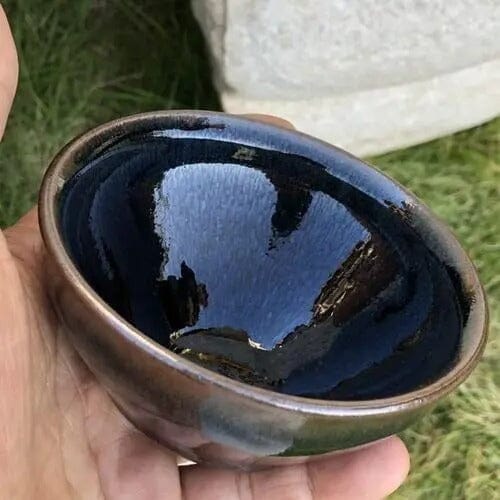
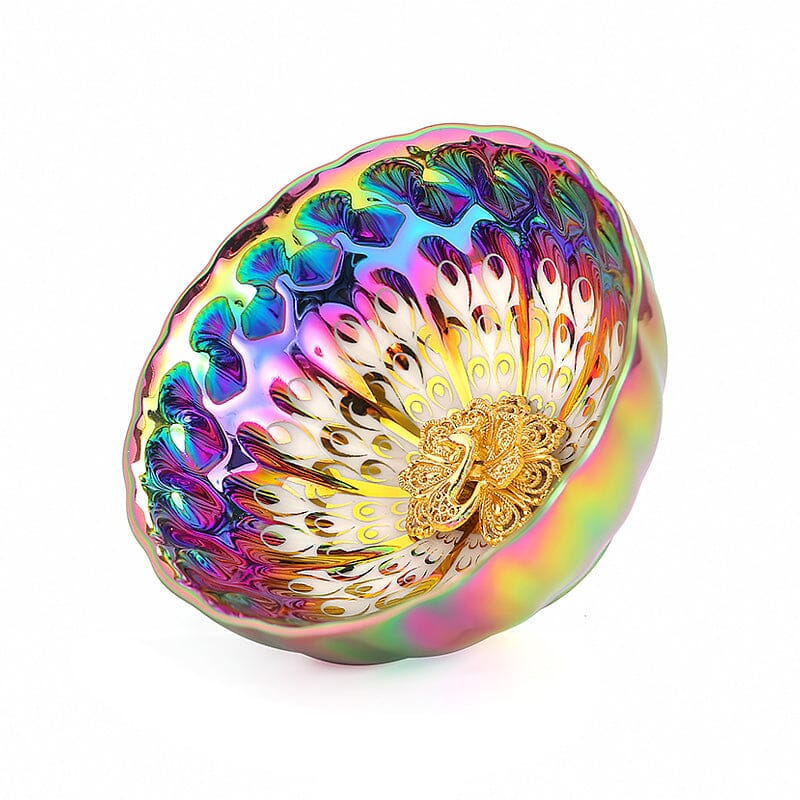
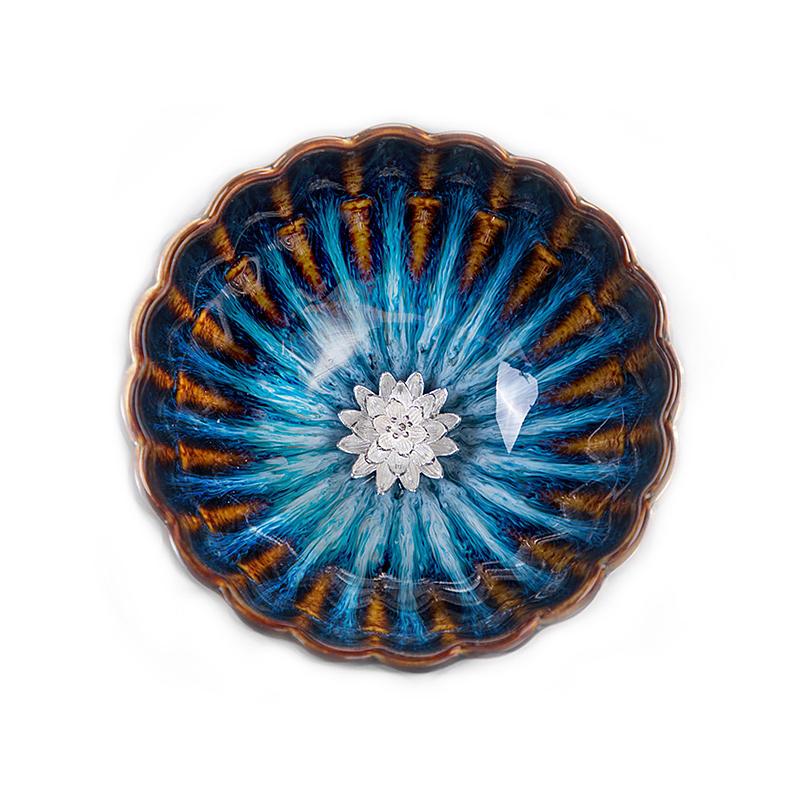
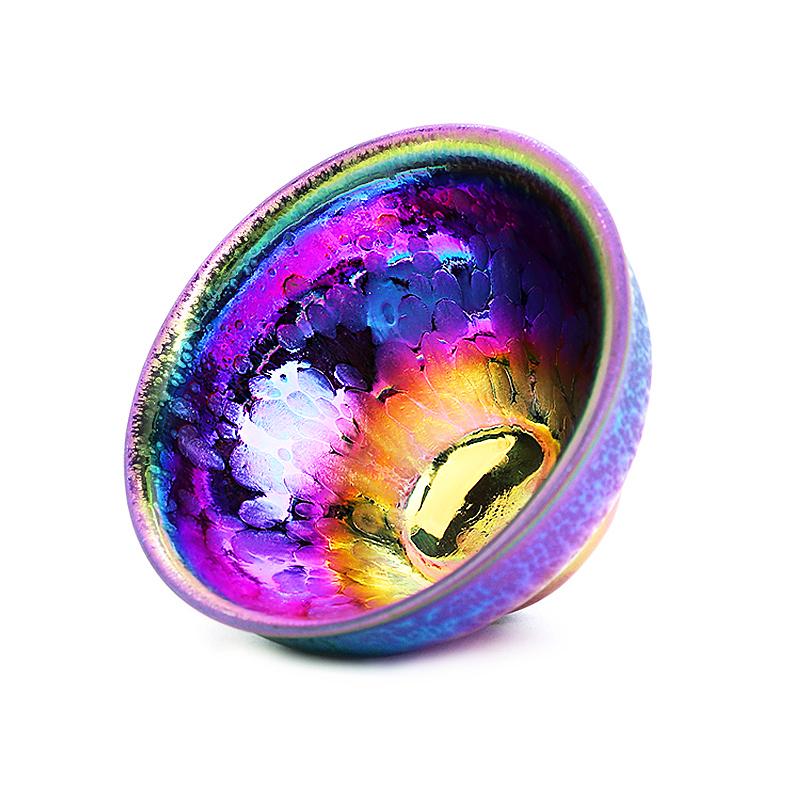
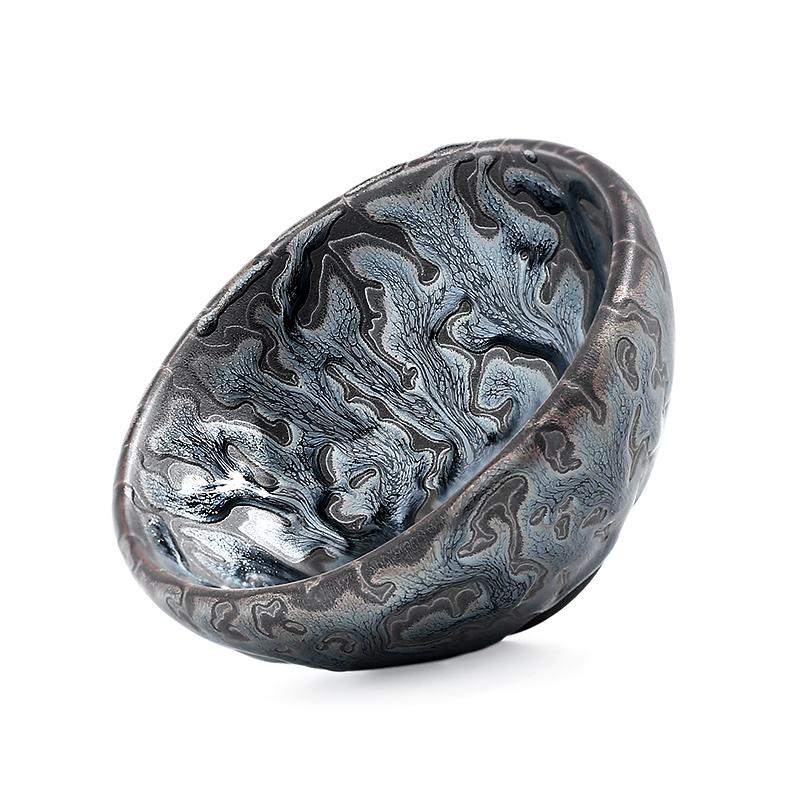
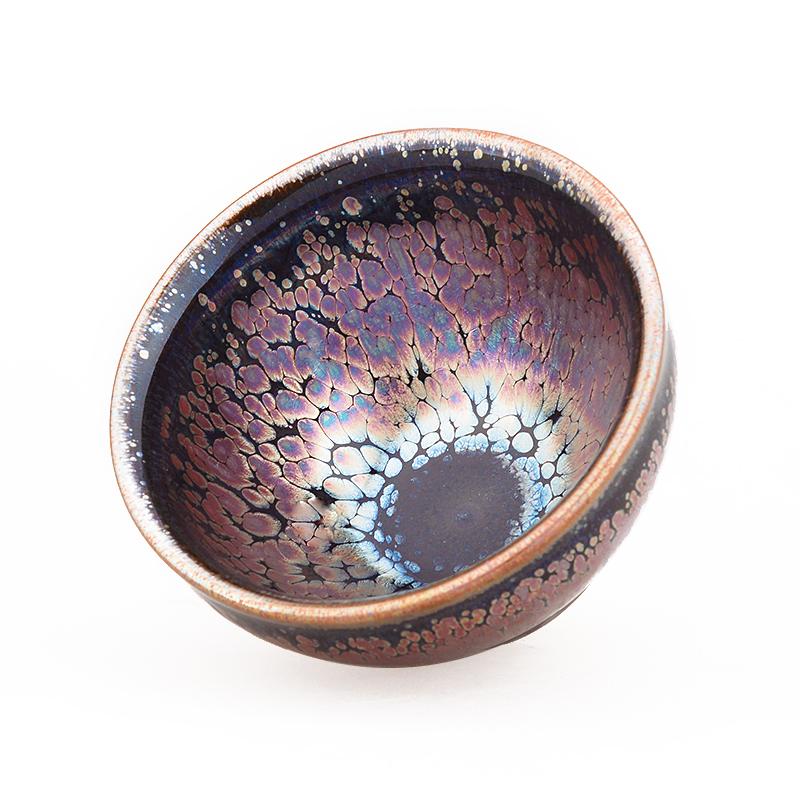
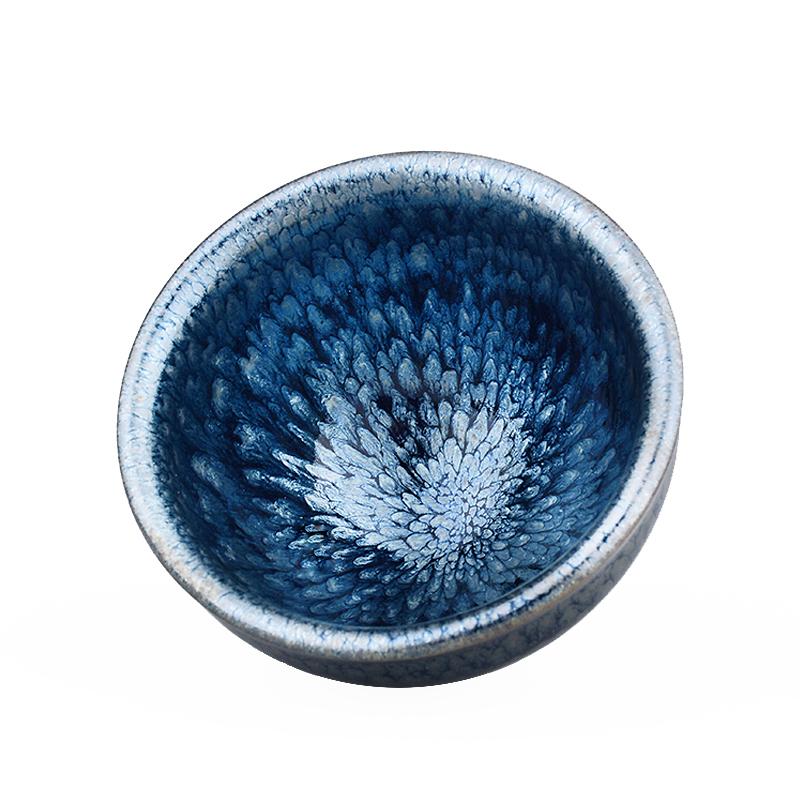
Share:
20 Tenmoku value indicators: A must-see before purchase
The correct method to open a Yixing teapot